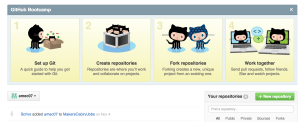GitHub: Development in a Networked Age
The Business Model
GitHub has revolutionized the software development process. Not only has it created a category-defining tool for coders to address a severe pain-point, version control, but it also hosts a platform through which developers can leverage the wealth of knowledge across the Git community of 11MM+ members to scale software development at unprecedented speeds and heights. What is perhaps most interesting about all of this is that this value creation is achieved without any money changing hands. In the old days, before we had the concept of the ‘git commit’, coders faced significant hurdles in collaborating on the same piece of software independently without corrupting the original code with contradictory fixes. Today, with GitHub, developers from all over the world across companies can work on the same source code and push changes to it in an organized fashion.

The Operating Model
Here’s how it works. A developer can post a project they are working on in a GitHub repository for access by other developers. Access can be public (free) or limited to certain individuals, say within a company, for a price. Contributing developers can ‘fork’, or copy the code, to make changes, and issue a ‘pull request’ to the original code owner so that he or she may review the changes and integrate the new code as appropriate. Changes are automatically tracked in a changelog.
Here’s how value is created through GitHub’s operating strategy:
- Superior organizational tools and decentralization of the innovation processes. Aside from the mechanics of tracking and managing source code changes, GitHub’s greatest value lies in how it enables software development outside of traditional bounds. GitHub currently houses over 30MM projects. Publicly accessible repos can be downloaded, changed, and published for the entire community to see. And herein lies the beauty of the platform: GitHub is just as much a functional developer tool as it is a social network.
- Harnessing human capital and a hacker culture for innovation beyond the current scope of existing projects. I, as a developer, can crowd source ideas and solutions to problems from a valuable community of like-minded experts whereas, previously, I may have been stuck on a problem or, even worse, writing code in an inefficient manner that I might otherwise be unaware of. Because project revisions are public, individuals feel an obligation to deliver quality feedback, which reinforces the value gained from the community and expands the sticky network effect of the product. Furthermore, GitHub has the potential to spawn a multitude of new projects that contribute value to society more broadly by connecting programmers online in a highly scalable way. And best of all – this value creation happens with 0 dollars of investment from a company or individual.
- Great UX. Git commands can be executed directly within a developer’s command line, the same place where code is written. This allows for developers to contribute to GitHub without disrupting their normal workflows, which is often the largest barrier to product adoption.
- Their platform approach sustains their competitive advantage. Because GitHub has become a central repository for developers’ previous work and a valued network where developers can ideate, switching costs are considerable. GitHub has achieved a level of scale and utility that has endowed it with benefits in a winner-takes-all context.
Conclusion: GitHub has dramatically lowered the barriers to software development at zero incremental cost to the individual. This has allowed for a next generation of software and app solutions to be built out, updated, and scaled at an unprecedented level. One has to wonder how sustainable their freemium business model will be – how will they fund platform improvements of their own, etc. Admittedly, they may never have to worry thanks to the self-reinforcing ecosystem they’ve built for the developer community as a whole.
Sources:
http://www.inc.com/magazine/201303/will-bourne/2-reasons-to-keep-an-eye-on-github.html



I agree that Github has created huge value in software development. With increasing collaboration between teams and geographically distributed teams (also across time zones), Github allows developers to have a consistent development and testing platforms to work on. This becomes even more important as more and more companies are adopting agile development and devops by which code is getting shipped to production faster. Github is also acting a personal marketing platform for developers to showcase their work to potential employers. This is creating huge network efforts and building barriers of entry for competitors. Another trend which is in favor of Github is the increase in Open Source platforms and softwares where Github is a good platform to host the code because of its wide adoption among developers. It will be interesting to see how Github is able to monetize its huge user base further.
I agree with the overall thesis of this piece — GitHub has certainly revolutionized the software development process. But I question the underlying assumption that GitHub is a traditional freemium model. GitHub has two separate products and separate revenue streams. It has public repositories that are free and open for anyone to access. But it also has a paid subscription product for teams to use private repositories. Unlike traditional freemium models (where this basic plan is free and the upgrade would come at a cost), GitHub has entirely separate product line for its free and paid service. By offering the free service to all engineers, GitHub uses a brilliant user growth strategy. Winning enterprise accounts, which is core to their B2B business, happens organically through the existing product line. To think about how the business model aligns with operating model I think requires considering these different value capture strategies. It will be interesting to see how they continue to monetize going forward (using GitHub education, gists, etc).